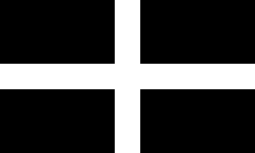Saint Piran's Flag
 |
|
| Names | St Piran's Flag, Baner Peran, An Gwynn ha Du |
|---|---|
| Use | Civil flag |
| Proportion | 5:3 |
| Adopted | 19th century |
| Design | A white cross on a black background. |
Saint Piran's Flag (Cornish: Baner Peran) is the flag of Cornwall, United Kingdom. The earliest known description of the flag as the Standard of Cornwall was written in 1838. It is used by Cornish people as a symbol of identity. It is a white cross on a black background.
The flag is attributed to Saint Piran, a 6th-century Cornish abbot. One early use of a white cross and black background design is the 15th-century coat of arms of the Saint-Peran family.
At the Thames Diamond Jubilee Pageant in June 2012, the flag was among those flown on the Royal Barge, Gloriana, though this was explained as "innocent" and "nothing constitutional".
There are claims that the design dates from prior to 1188 when the flag was used in the Crusades, and an article in the Encyclopædia Britannica tells that the flag was carried by the Cornish contingent at the Battle of Agincourt (1415). However, the reference given by the Encyclopædia Britannica seems to have been confused with one that comes from a 1590 poem entitled Poly-Olbion by Michael Drayton. It states that the banner carried by the Cornish men at Agincourt depicted two Cornish wrestlers in a hitch.
The earliest known evidence of this flag was recorded by Davies Gilbert in his 1838 work: The History of Cornwall, in which he gives reference to
a white cross on a black ground [that] was formerly the banner of St Perran and the Standard of Cornwall; probably with some allusion to the black ore and the white metal of tin
The fact that Gilbert identifies it as being "formerly" a standard of Cornwall implies that he believed it to have been used before 1838. However, Gilbert did not leave a record of his background research, and referred only to his "recollection".
...
Wikipedia
